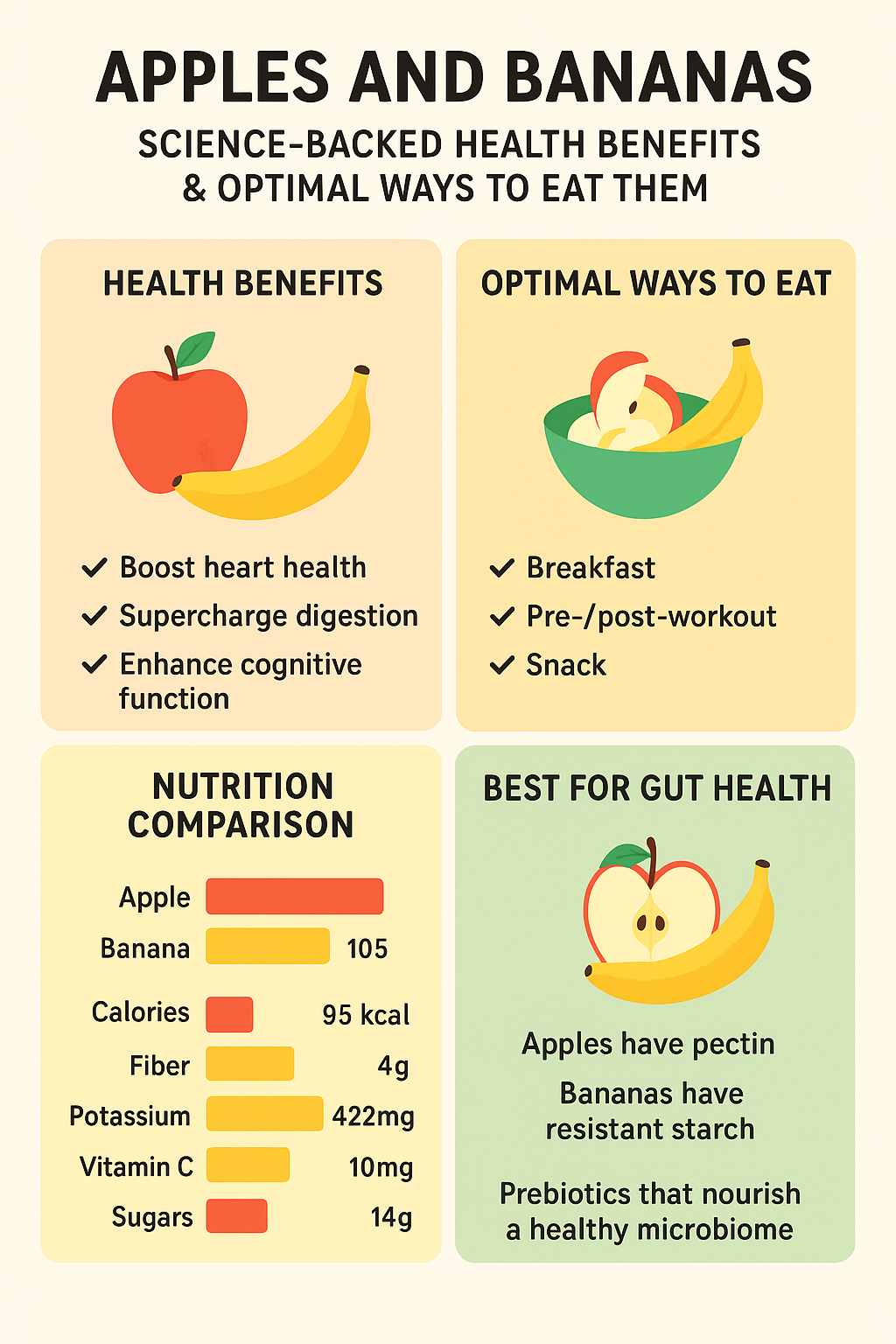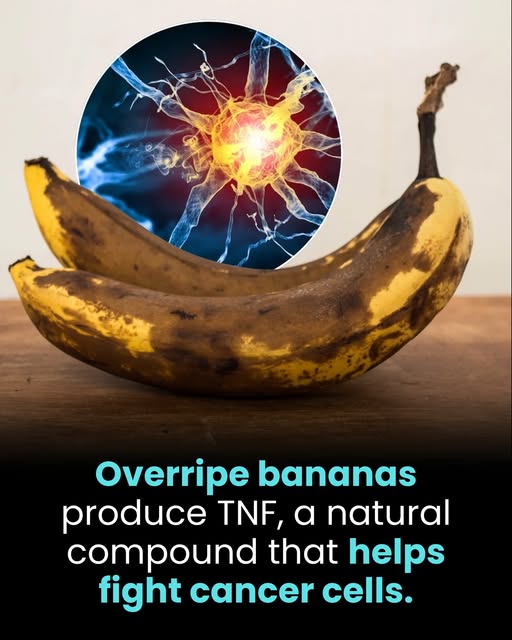Apples and Bananas: Science-Backed Health Benefits & Optimal Ways to Eat Them
We often hear about the individual benefits of apples and bananas, but the real nutritional power emerges when we understand them not just as fruits, but as functional tools for different body systems. By examining the science behind pectin and resistant starch, we can see how this common duo works in a complementary cycle: the apple preparing the gut environment and the banana nourishing it directly. This guide moves beyond basic nutrition facts to show you how to strategically use these fruits to target everything from your morning energy to your evening sleep quality.

Apple vs Banana: A Nutritional Breakdown (Which is Better?)
While both fruits are nutritional champions, they offer different strengths. Here is a comparison of key nutrients in a medium-sized apple and banana.
| Nutrient | Apple (1 medium) | Banana (1 medium) |
| Calories | 95 kcal | 105 kcal |
| Fiber | 4g | 3g |
| Potassium | 195mg | 422mg |
| Vitamin C | 8mg | 10mg |
| Sugars | 19g | 14g |
Featured Snippet Bait:
Viewing this table as a menu of benefits, not just nutrients, allows for strategic choice. Are you fueling a workout or healing your gut? The ‘better’ fruit is the one that aligns with your body’s immediate objective.
Here’s a detailed comparison to help you decide which fruit wins for your goals.
For Optimal Digestion and Regularity: Choose Apples
If your primary focus is digestive health, apples often have the edge.
- Why Apples Win: Apples are a superior source of dietary fiber, particularly a soluble fiber called pectin. Pectin acts as a prebiotic, feeding the beneficial bacteria in your gut and adding bulk to stool to promote regularity and support a healthy microbiome.
- Pro Tip: Eat apples with the skin on, as a significant portion of their fiber and antioxidants is found there.
Apple Health Benefits: Why ‘An Apple a Day’ Works
Beyond the fiber that apples are famous for, their value lies in a synergistic combination of compounds. The phrase ‘an apple a day keeps the doctor away’ holds up when we look at the specific mechanisms. Here are more reasons why apples are a health essential:
1. A Dual-Action Digestive Aid: The pectin in apples is more than just bulk. As a prebiotic, it feeds beneficial gut bacteria. Furthermore, a 2015 study in the Journal of Food Science demonstrated that polyphenols in apple peel can reduce gastric acid by up to 20%, suggesting a soothing effect on the stomach lining alongside the fiber’s role in promoting regularity.
2. Antioxidant Synergy: It’s not just about Vitamin C. Apples contain a spectrum of flavonoids like quercetin, a powerful flavonoid antioxidant concentrated primarily in the skin. Quercetin is linked to reducing chronic disease risk and possesses strong anti-inflammatory properties.
3. Satiety and Weight Management: The high water content and fiber create volume, physically filling the stomach and triggering satiety signals. This makes a low-calorie apple an effective tool for controlling overall calorie intake.”
Gut Health: Apples and Bananas as Natural Prebiotics
Both apples and bananas have powerful prebiotic effects that nourish your gut. Prebiotics are non-digestible food components that feed the good bacteria in your gut. As a result, a healthy gut microbiome can improve everything from digestion to mental health.
- Apples and Pectin: Apples contain a special type of fiber called pectin. When your gut bacteria ferment pectin, they produce short-chain fatty acids that reduce inflammation and strengthen your gut lining.
- Bananas and Resistant Starch: Green bananas are especially rich in resistant starch. Your body doesn’t digest this starch in the small intestine, so it travels to the large intestine where it becomes food for your good gut bacteria.
Banana Health Benefits: More Than Just Potassium
While bananas are best known for their potassium content (about 422 mg per medium fruit), their cardiovascular benefits go much further. According to the World Health Organization’s guidance on potassium intake and cardiovascular disease prevention, a diet rich in potassium from foods like bananas can lower stroke risk by up to 24%, highlighting their role in supporting heart health. Here are some additional benefits of bananas:
- Workout Recovery: Bananas are rich in magnesium and carbohydrates, which combat muscle cramps and replenish your energy stores after exercise.
- Mood Booster: Bananas contain Vitamin B6 and the amino acid L-Tyrosine, which are necessary for your body to produce its own neurotransmitters, including dopamine. This supporting role in brain chemistry can contribute to improved mood and mental clarity. Discover more about nourishing foods that support mental wellness in our comprehensive nutrition guide.
- What Happens if You Eat Bananas Every Day? Eating a banana daily is generally safe and beneficial. However, a banana’s glycemic index can spike if it’s overripe, which could pose a risk for people with diabetes.
Overripe Bananas: A Hidden Immune-Boosting Powerhouse
When you see brown spots on a banana, don’t be too quick to toss it out. Those spots signal that the fruit has entered a powerful nutritional phase. As bananas ripen, they produce higher levels of tumor necrosis factor (TNF)—a natural compound that helps the immune system identify and destroy abnormal or damaged cells, this is according to a study published in the journal Food Science and Technology Research. This process supports your body’s defense mechanisms and may play a role in preventing certain illnesses.

The transformation that happens as bananas mature essentially turns them into a functional food—one that not only nourishes but also enhances immune resilience. Including a few slices of overripe banana in your smoothies or snacks is an easy, natural way to strengthen your body’s internal defenses.
While more research is needed to fully understand these effects in humans, this finding underscores a key takeaway: in the world of apples and bananas, even the ripest banana has a meaningful role to play in supporting long-term wellness.
When Is the Best Time to Eat Apples and Bananas?
While apples and bananas are healthy choices any time of day, timing your consumption can help you maximize their unique benefits to support specific health goals. The ideal time to enjoy this powerful fruit duo depends on what you want to achieve, from boosting energy to improving sleep.
Here’s a breakdown of the best times to eat apples and bananas for optimal results.
1. In the Morning: To Kickstart Digestion and Energy
Starting your day with apples and bananas can provide a sustained energy release and promote digestive health.
- Apples for Fiber: Apples are exceptionally high in soluble fiber (pectin). Consuming this fiber in the morning can help stimulate digestive juices and promote bowel regularity throughout the day. A study published by the National Institutes of Health (NIH) confirms that adequate fiber intake is crucial for maintaining digestive health and preventing constipation.
- Bananas for Sustained Energy: The natural sugars in bananas provide a quick source of energy to break your overnight fast, while their fiber and resistant starch (especially in slightly green bananas) help ensure that energy is released slowly, preventing a mid-morning crash. This combination of quick and sustained energy makes them a perfect morning fuel.
2. Pre-Workout: For Sustainable Fuel (30-60 Minutes Prior)
Need energy for your exercise routine? The combination of apples and bananas is an excellent natural pre-workout snack.
- Why It Works: Apples provide a source of complex carbohydrates that release energy steadily. Bananas contribute simple carbohydrates for immediate energy, along with potassium—an electrolyte vital for nerve function and muscle contraction. This one-two punch helps ensure you have the stamina and electrolyte balance to power through your workout effectively and may help prevent muscle cramps.
3. Post-Workout: For Optimal Muscle Recovery (Within 30 Minutes)
This is arguably the most advantageous time to eat a banana, often paired with a protein source.
- Bananas for Recovery: The fast-digesting carbohydrates in bananas help replenish glycogen stores—the energy reserves in your muscles that get depleted during exercise. This process is essential for muscle repair and recovery. The potassium also helps restore electrolytes lost through sweat.
- Pro Tip: For a perfect post-workout meal, pair a banana with a source of protein, like Greek yogurt or a scoop of protein powder, to further aid muscle repair.
4. In the Evening: To Support Relaxation and Sleep
Surprisingly, these fruits can also be a great evening snack, particularly for those struggling with sleep.
- Bananas for Sleep: Bananas contain two key nutrients that promote sleep: magnesium, which acts as a muscle relaxant, and the amino acid tryptophan. Tryptophan is a precursor to serotonin and melatonin, the hormones that regulate sleep. Research highlighted by the National Sleep Foundation suggests that foods containing these compounds can support better sleep quality.
- Apples for Satiety: An apple in the evening can provide a feeling of fullness without being heavy on calories, helping to prevent late-night cravings for unhealthy snacks that can disrupt sleep.
The Bottom Line: There’s no single “right” time. Listen to your body’s needs. Whether you need morning fiber, workout fuel, or evening relaxation, strategically incorporating apples and bananas into your daily routine can help you achieve your wellness goals.
| Health Goal | Best Choice | Why |
|---|---|---|
| Digestion | Apple | High in soluble fiber (pectin) |
| Workout Fuel | Banana | Rich in potassium and quick carbs |
| Heart Health | Banana | Potassium lowers blood pressure |
| Gut Health | Both | Prebiotic fibers support microbiome |
| Skin & Beauty | Apple | Vitamin C supports collagen |
| Immunity | Overripe Banana | TNF compounds enhance defense |
Who Should Be Mindful Eating Bananas? (3 Considerations)
Bananas are a nutritional powerhouse, packed with potassium, vitamin B6, vitamin C, and fiber. For most people, they are a convenient and healthy snack. However, due to their specific nutrient profile, certain individuals need to be cautious or even avoid them altogether. Understanding these concerns is key to making informed dietary choices. Here are the three primary risk groups who should be mindful of their banana intake:
1. Individuals with Late-Stage Kidney Disease or Kidney Failure
This is the most critical group to consider. Bananas are famously high in potassium, a mineral essential for heart function and muscle contractions. Healthy kidneys expertly regulate potassium levels in the blood by filtering out and excreting any excess.
- The Risk: For individuals with compromised kidney function (especially those in late-stage chronic kidney disease or on dialysis), this regulatory system fails. Consuming high-potassium foods like bananas can lead to a condition called hyperkalemia—abnormally high levels of potassium in the blood.
- Why It’s Dangerous: Hyperkalemia can cause severe muscle weakness, irregular heart rhythms (arrhythmias), and even heart attack. It is a serious and potentially life-threatening condition.
- What to Do: If you have kidney disease, it is crucial to work with your doctor or a registered dietitian. They will likely prescribe a low-potassium diet and may advise you to limit or avoid bananas, opting instead for lower-potassium fruits like apples, berries, or grapes.
2. Individuals with a Banana or Latex Allergy
While uncommon, banana allergies do exist and are often linked to other allergies.
- The Risk: Some people have an allergy to specific proteins in bananas. This can trigger an immune response ranging from mild to severe (anaphylaxis). Symptoms can include itching or swelling of the lips, tongue, and throat, hives, wheezing, and digestive distress.
- The Latex-Fruit Connection: Importantly, a banana allergy is frequently associated with latex allergy. This is due to a phenomenon called cross-reactivity, where the proteins in latex are similar to those found in certain fruits, including bananas, avocados, and kiwis. If you have a known latex allergy, you have a higher probability of being allergic to bananas.
- What to Do: If you experience any allergic symptoms after eating a banana, stop consumption immediately and consult an allergist for proper testing and diagnosis.
3. Individuals with Poor Blood Sugar Control or Type 2 Diabetes
This point requires nuance. Bananas are not off-limits for people with diabetes, but portion control and ripeness are paramount.
Pair with Protein or Fat: Enjoy your banana with a source of protein or healthy fat, such as a handful of nuts or a spoonful of nut butter. This combination can further slow down digestion and sugar absorption.
The Risk: The carbohydrate content in a banana is primarily sugar and starch. As a banana ripens, its starches convert into simple sugars (sucrose, glucose, and fructose). This means an overripe, brown-spotted banana has a much Higher Glycemic Index (GI) than a green-tipped, underripe one, potentially causing a more rapid spike in blood sugar levels.
Why It Matters: For individuals with insulin resistance, prediabetes, or type 2 diabetes, managing blood sugar spikes is a primary goal of dietary management. Consuming large quantities of very ripe bananas can disrupt this balance.
Key Takeaway:
The Bottom Line: Your Daily Fruit Optimization Plan: Incorporate one apple and one banana daily in different forms — sliced over oats, blended into a smoothie, or paired with nuts. Rotate ripeness levels (slightly green to ripe bananas) to balance energy release and gut benefits. This practical approach ensures you gain their full, science-backed advantages across digestion, immunity, and heart health.
Choose Underripe Bananas: Opt for bananas that are still slightly green at the tips. They contain more resistant starch, which is digested more slowly and has a gentler impact on blood sugar.
Loved learning about the power of apples and bananas? Discover how berries and citrus fruits boost immunity and health in our comprehensive guide.
Frequently Asked Questions: Apples & Bananas
Can apples and bananas help with weight loss?
Yes, combining apples and bananas creates a nutritious and satisfying snack. The pairing offers a balance of quick energy from the bananas and sustained fullness from the apple’s fiber. For even more staying power, add a source of protein or healthy fat like a handful of nuts or a spoonful of nut butter.
How do apples and bananas improve gut health in surprising ways?
Emerging research shows that apples and bananas don’t just aid digestion — they actually help your gut create natural anti-inflammatory compounds. The pectin in apples and the resistant starch in bananas are fermented by gut bacteria to produce short-chain fatty acids (like butyrate), which nourish your intestinal lining and strengthen immune defenses. So when you eat apples and bananas together, you’re essentially feeding your body’s “internal pharmacy” that protects against inflammation and boosts overall wellness.
Which provides better energy before a workout, an apple or a banana?
For most people, a banana is the superior pre-workout fuel. Its higher carbohydrate content and electrolytes like potassium provide a quick source of energy and help prevent muscle cramps. An apple can also work well for a lighter, longer-lasting energy boost due to its fiber content.
